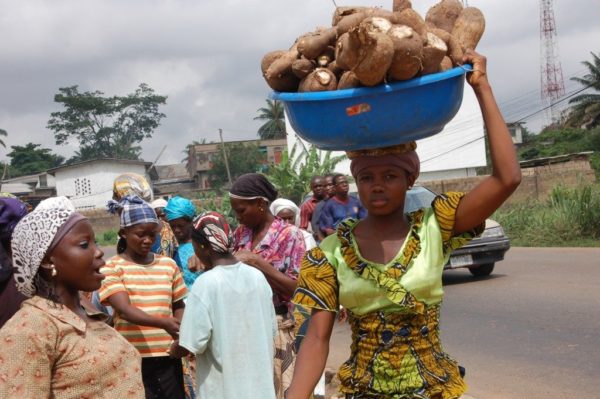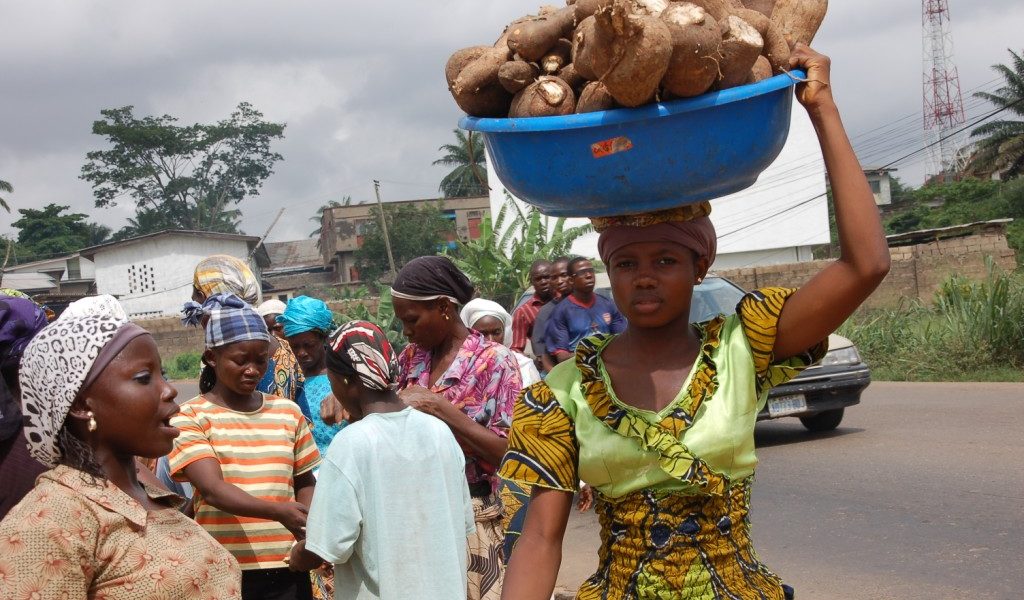“In many developing countries, the labor market has left a high proportion of young people out of employment and unable to sustain their livelihoods,” explains Dr. Netsayi Mudege, leader of the ‘Gender equity and youth employment’ research cluster (CC5.3) of the CGIAR Research Program on Roots, Tubers and Bananas (RTB).
“Under such conditions, agriculture related youth programs and youth oriented research can provide an opportunity to build a critical mass of young women and men farmers with skills and capacity to take up opportunities in the agricultural sector and improve their livelihoods. However, agriculture has to be attractive to young people and offer a viable alternative livelihood,” she adds.

Woman carrying a bowl of cassava on her head at cassava processing center at Onipepeye area, Ibadan Nigeria
RTB has prioritized tackling these issues through a dedicated research cluster (CC5.3) which is housed under the program’s Flagship project 5 on ‘Improving livelihoods at scale’. The cluster team came together for a ‘youth reflections day and cluster kick off meeting’ from May 26 – 27 in Amsterdam, to develop a joint vision on strategy and research ideas that will guide their agenda in the coming years. A total of 14 participants attended from the International Potato Center, Bioversity International, International Institute of Tropical Agriculture as well as two participants from the World Agroforestry Centre and one participant from the International Maize and Wheat Improvement Center who were invited to share their perspectives and learn from the RTB work.
On the first day, Jim Sumberg, from the Institute of Development Studies at the University of Sussex, Brighton, accompanied and guided the team in its reflection and understanding of current issues on youth in agriculture, including existing theories and methodologies. “Young adults have multiple identities – daughter/son, students, farmer, laborer, migrant, spouse, parents – we need to avoid simplistic labels and illusions of linearity, as youth is a dynamic and not a homogenous category,” he said.
The team began by discussing the cluster’s approach to youth in agriculture, and the entry point for the youth strategy to be developed. Reflections about the myriad issues affecting youth, and understanding what has already been studied and done is crucial to define the gaps and formulate the new strategy and research agenda.
One participant summed up why it was important to focus on youth issues in RTB as follows: “A central problem is how young people currently engage in agriculture and how we can keep them engaged and help them build solid livelihoods strategies. We need to understand the needs of young people and men and women in a constantly changing rural environment.”
The rural landscape is being transformed through the introduction of technologies and ICTs; climate change is also affecting rural livelihoods and households have to change to be able to adapt. Young people are receiving more education which has also led to changes in their aspirations. A youth responsive agriculture research approach needs to incorporate and address these transformations if agriculture is to become a viable livelihood option for young people.
To define a vision and mission for RTB youth work, the team will conduct research to understand and define the drivers and opportunities for the involvement of young men and women in the rural economy. Young people are embedded in social relations that are also characterized by power hierarchies and these can shape their opportunities.
Currently the team has been engaged with the GENNOVATE, a global comparative research initiative which addresses the question of how gender norms and agency influence men, women and youth to adopt innovation in agriculture and natural resource management. Initial findings include that young people are not interested to stay in agriculture and parents aspire for their children to have occupations outside of agriculture as it is perceived to be a ‘dirty job’, involve hard manual labor and not a sustain livelihood. Young people often view agriculture as an option when other options have failed. The team will use some of the findings from such studies to help define the youth strategy for RTB and ensure that RTB researchers understand the opportunities and potential impact on the involvement of young people.
In line with this, cluster researchers will develop a framing paper for youth research and approaches in RTB. This framing paper will consist of a literature on youth, define broader conceptual frameworks and approaches as well as try to identify broad research questions for RTB to engage with. The paper will provide a critical building block for the development of an RTB youth strategy which will outline how to engage with youth (young men and women) in a meaningful way.
Blog contributed by Claudia Babini, Netsayi Mudege and Holly Holmes
